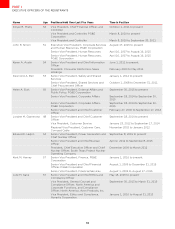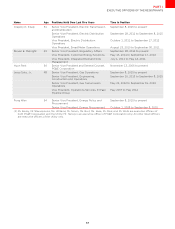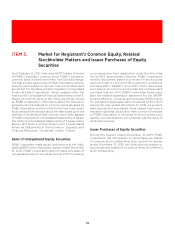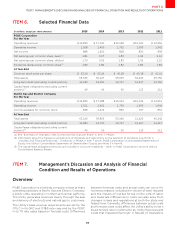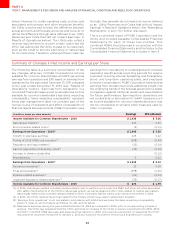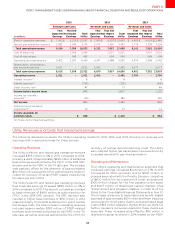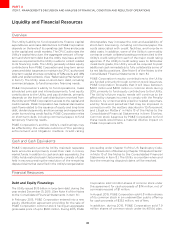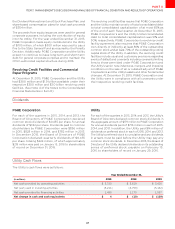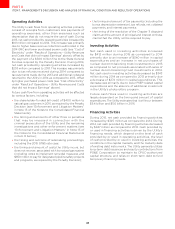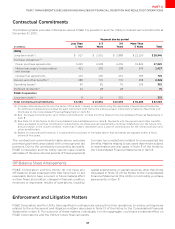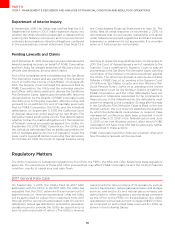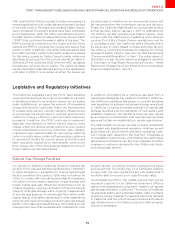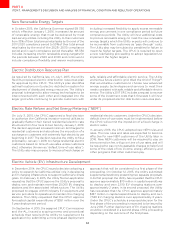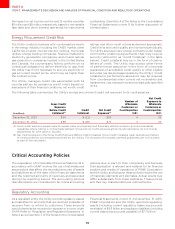PG&E 2015 Annual Report Download - page 54
Download and view the complete annual report
Please find page 54 of the 2015 PG&E annual report below. You can navigate through the pages in the report by either clicking on the pages listed below, or by using the keyword search tool below to find specific information within the annual report.
46
PART II
ITEM 7.MANAGEMENT’S DISCUSSION AND ANALYSIS OF FINANCIAL CONDITION AND RESULTS OF OPERATIONS
Liquidity and Financial Resources
Overview
The Utility’s ability to fund operations, finance capital
expenditures, and make distributions to PG&E Corporation
depends on the levels of its operating cash flows and access
to the capital and credit markets. The CPUC authorizes the
Utility’s capital structure, the aggregate amount of long-
term and short-term debt that the Utility may issue, and the
revenue requirements the Utility is able to collect related
to its financing costs. The Utility generally utilizes equity
contributions from PG&E Corporation and long-term senior
unsecured debt issuances to maintain its CPUC-authorized
long-term capital structure consisting of 52% equity and 48%
debt and preferred stock. (See “Ratemaking Mechanisms”
in Item 1). The Utility relies on short-term debt, including
commercial paper, to fund temporary financing needs.
PG&E Corporation’s ability to fund operations, make
scheduled principal and interest payments, fund equity
contributions to the Utility, and pay dividends, primarily
depends on the level of cash distributions received from
the Utility and PG&E Corporation’s access to the capital and
credit markets. PG&E Corporation has material stand-alone
cash flows related to the issuance of equity and long-term
debt, dividend payments, and borrowings and repayments
under its revolving credit facility. PG&E Corporation relies
on short-term debt, including commercial paper, to fund
temporary financing needs.
PG&E Corporation’s and the Utility’s credit ratings may
be aected by the ultimate outcome of the pending
enforcement and litigation matters. Credit rating
downgrades may increase the cost and availability of
short-term borrowing, including commercial paper, the
costs associated with credit facilities, and long-term
debt costs. In addition, some of the Utility’s commodity
contracts contain collateral posting provisions tied to the
Utility’s credit rating from each of the major credit rating
agencies. If the Utility’s credit rating were to fall below
investment grade, the Utility would be required to post
additional cash immediately to fully collateralize some of
its net liability positions. (See Note 9 of the Notes to the
Consolidated Financial Statements in Item 8.)
PG&E Corporation’s equity contributions to the Utility
are funded primarily through common stock issuances.
PG&E Corporation forecasts that it will issue between
$600 million and $800 million in common stock during
2016, primarily to fund equity contributions to the Utility.
The Utility’s future equity needs will continue to be
aected by charges incurred to comply with the Penalty
Decision, by unrecoverable pipeline-related expenses,
and by fines and penalties that may be imposed in
connection with the matters described in “Enforcement
and Litigation Matters” in Note 13 of the Notes to the
Consolidated Financial Statements in Item 8 below.
Common stock issuances by PG&E Corporation to fund
these needs would have a material dilutive impact on
PG&E Corporation’s EPS.
Cash and Cash Equivalents
PG&E Corporation and the Utility maintain separate
bank accounts and primarily invest their cash in money
market funds. In addition to cash and cash equivalents, the
Utility holds restricted cash that primarily consists of cash
held in escrow pending the resolution of the remaining
disputed claims that were filed in the Utility’s reorganization
proceeding under Chapter 11 of the U.S. Bankruptcy Code.
(See “Resolution of Remaining Chapter 11 Disputed Claims”
in Note 13 of the Notes to the Consolidated Financial
Statements in Item 8.) The Utility is uncertain when and
how the remaining disputed claims will be resolved.
Financial Resources
Debt and Equity Financings
The Utility issued $1.15 billion in long-term debt during the
year ended December 31, 2015. (See Note 4 of the Notes
to the Consolidated Financial Statements in Item 8.)
In February 2015, PG&E Corporation entered into a new
equity distribution agreement providing for the sale of
PG&E Corporation common stock having an aggregate
gross sales price of up to $500 million. During 2015, PG&E
Corporation sold 1.4 million shares of common stock under
this agreement for cash proceeds of $74 million, net of
commissions paid of $1 million.
In August 2015, PG&E Corporation sold 6.8 million shares
of its common stock in an underwritten public oering
for cash proceeds of $352 million, net of fees.
In addition, during 2015, PG&E Corporation sold 7.9
million shares of common stock under its 401(k) plan,


